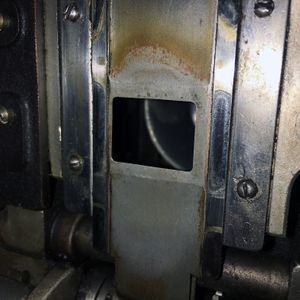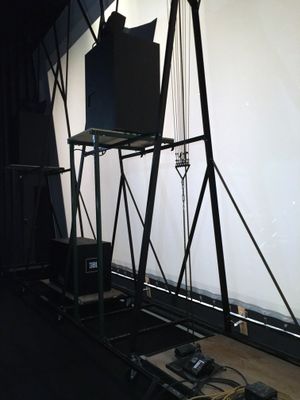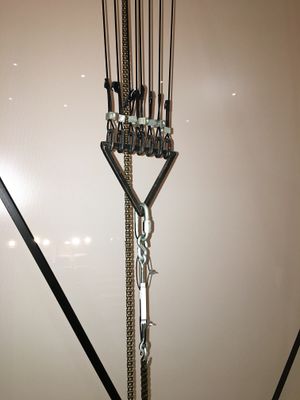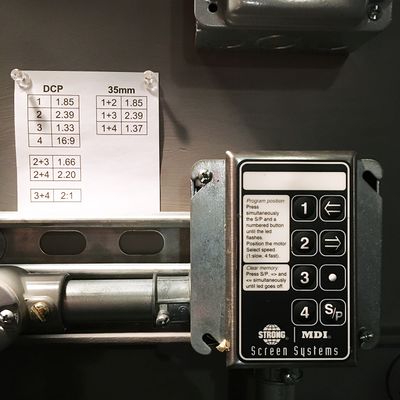| Welcome to Sprocket School! This project is maintained by volunteer editors. Learn more about how this works. |
Masking: Difference between revisions
No edit summary |
JesseCrooks (talk | contribs) |
||
| (29 intermediate revisions by 2 users not shown) | |||
| Line 1: | Line 1: | ||
Masking is the material on the border of the [[screens|screen]] that covers the portion of the screen outside the picture area | <references /> | ||
Masking is the material on the border of the [[screens|screen]] that covers the portion of the screen outside the picture area. The top of the screen is covered by a valence, and the fixed drapery hanging below the screen is referred to as the skirt. Some masking is fixed in place, while some masking is adjustable either by hand or via a motorized masking system. Masking is typically matte black, with the side masking and skirt made of a lightweight fabric that is acoustically transparent so that it doesn’t muffle the screen speakers. | |||
Masking is | ==Purpose== | ||
<blockquote> | |||
''Where the black border is used there is not only less distraction for the eye, but the effect of added light brilliancy is had without its actuality.'' | |||
— F. H. Richardson | |||
<ref>F.H Richardson. ''Motion Picture Handbook: a guide for managers and operators of motion picture theatres'', 3rd ed. (New York: Chalmers Publishing Company,1916), 178.</ref> | |||
</blockquote> | |||
Masking serves several purposes in exhibition settings. When projecting film, the [[aperture plates|aperture plate]] casts a blurry shadow because it is not on the same focal plane as the film, and masking is used to crop off this shadow and giving the illusion of a sharp edge. It also hides structural elements of the screen and mechanical elements of the masking system itself. Masking also absorbs lights around the visible image area projected on screen, making the image stand out and appear brighter. | |||
==History== | ==History== | ||
[[File:Powers Sound Aperture.JPG|A 1.37 aperture plate on a Powers Cameragraph No. 6.|right|thumb|300px]] | |||
[[File:Masking - round corners.jpg|Silent era masking with rounded corners, F.H Richardson ''Motion Picture Handbook: a guide for managers and operators of motion picture theatres'', 3rd ed., 1916.|right|thumb|300px]] | |||
In the silent era, projectors had a fixed aperture and screens had fixed masking. Apertures typically had rounded corners, which were often reflected in the masking. In the early years, a border was either painted directly onto the screen with matte black paint or constructed out of matte black fabric. However, at theaters that employed a stereopticon that projected a taller image than the 35mm picture, the film presentation could not be properly masked. | In the silent era, projectors had a fixed aperture and screens had fixed masking. Apertures typically had rounded corners, which were often reflected in the masking. In the early years, a border was either painted directly onto the screen with matte black paint or constructed out of matte black fabric. However, at theaters that employed a stereopticon that projected a taller image than the 35mm picture, the film presentation could not be properly masked. | ||
The use of fixed masking, often with rounded corners, continued after the standardization of 1.37:1 as the aspect ratio for sound film. It was not until the proliferation of widescreen [[aspect ratios]] in the 1950s that theaters had to adapt by providing adjustable masking, which by necessity resulted in sharp corners on the screen. There were a few exceptions to this, including early pre-1950s widescreen gimmicks like [https://www.chicagofilmsociety.org/2016/02/02/magnascope// Magnascope] which would have required adjustable masking as early as the mid-1920s. | The use of fixed masking, often with rounded corners, continued after the standardization of 1.37:1 as the aspect ratio for sound film. It was not until the proliferation of widescreen [[aspect ratios]] in the 1950s that theaters had to adapt by providing adjustable masking, which by necessity resulted in sharp corners on the screen. There were a few exceptions to this, including early pre-1950s widescreen gimmicks like [https://www.chicagofilmsociety.org/2016/02/02/magnascope// Magnascope] which would have required adjustable masking as early as the mid-1920s for theaters interested in screening films using this early widescreen projection process. | ||
The early days of widescreen were fairly chaotic as studios tried out different widescreen aspect ratios. Many films released during this period were produced with the understanding that some theaters would still need to screen them 1.37:1 while those who were able (i.e had updated their theaters to accommodate widescreen) would screen them in a widescreen aspect ratio, with widescreen masking. | |||
===Fixed Height Screens=== | |||
By the late 1950s most American studios eventually coalesced around the 1.85:1 and 2.39:1 formats for 35mm, with some exceptions. Many theaters began installing masking systems that could only mask these two aspect ratios. The masking was typically fixed-height, with the sides expanding for 2.39 and narrowing for 1.85. This strikes a good balance between the aperture size and the illuminated surface area of the screen, with the larger Scope aperture corresponding to a larger projected image. With the same light output from the lamp, both aspect ratios can be illuminated within the SMPTE-specified parameters. | |||
===Fixed Width Screens=== | |||
Although less common than fixed height screens, some theaters have fixed-width screens on which the picture area becomes taller for narrower aspect ratios and shortens for wider aspect ratios. This is common in theaters built before the widescreen era that retained their original screen footprint (rather than installing a wider screen in front of the original proscenium, for example). It is also common in theaters in which the width of the auditorium is the limiting factor, such as single screens that have been twinned. | |||
In the digital era, | ===Current Practice=== | ||
Although being able to only accommodate 1.85:1 "Flat" and 2.39:1 "Scope" works well for venues screening mostly new releases and older American titles produced after the "widescreen chaos" era of the 1950s, those committed to the proper presentation of films from any era, and any country, need more flexibility. They require masking systems that enable them to properly mask films of a wider variety of aspect ratios that span the entire history of cinema. While it's rare to encounter a venue operating today that has the masking, lenses, and aperture plates needed to accommodate every single aspect ratio, including those for both 35mm and [[70mm]], venues that routinely screen a wide variety of repertory titles will usually be able to accommodate full-frame 1.33:1 for silent films, 1.37:1, the widescreen aspect ratios 1.85:1 and 1.66:1, and 2.39:1. | |||
In the digital era, some first-run theaters (or theaters built in the digital era) started to move away from the use of adjustable masking, relying instead on the projected image to provide a sharp edge to the picture. However, improperly masked digital images will have grey letterboxing or pillarboxing around the image instead of a black border. | |||
==Masking Systems== | ==Masking Systems== | ||
| Line 29: | Line 45: | ||
===Motors & Rigging=== | ===Motors & Rigging=== | ||
[[File:Masking Rigging.JPG|Masking rigging.|right|thumb|300px]] | |||
[[File:Masking Clew.JPG|A clew distributing the load to multiple cables to support the upper masking evenly across its length.|right|thumb|300px]] | |||
Some masking systems are fully manual, but most are motorized. Motorized systems may be chain-drive or cable-driven, with either a sprocket or cable drum attached to the motor shaft. For motorized systems, stops are programmed for each format. For manual systems, the stops must be marked somewhere on the masking system (ex., tape may be applied to the side of the screen frame or the top of the skirt to denote how far the sides should be brought in). | Some masking systems are fully manual, but most are motorized. Motorized systems may be chain-drive or cable-driven, with either a sprocket or cable drum attached to the motor shaft. For motorized systems, stops are programmed for each format. For manual systems, the stops must be marked somewhere on the masking system (ex., tape may be applied to the side of the screen frame or the top of the skirt to denote how far the sides should be brought in). | ||
| Line 36: | Line 56: | ||
It’s a good idea to keep spare fuses on-hand for the masking motors, since masking frozen in the wrong position may require show cancellations. | It’s a good idea to keep spare fuses on-hand for the masking motors, since masking frozen in the wrong position may require show cancellations. | ||
===Masking Controls=== | ===Masking Controls=== | ||
| Line 56: | Line 71: | ||
In particular, a masking change from a larger image to a smaller image should be avoided when the audience is present, as it can make the projected image seem less impressive. | In particular, a masking change from a larger image to a smaller image should be avoided when the audience is present, as it can make the projected image seem less impressive. | ||
==Related Pages== | |||
* [[Aspect ratios]] | |||
* [[Aperture plates]] | |||
==Resources== | |||
* [http://www.widescreenmuseum.com/ American Widescreen Museum] | |||
==References== | |||
[[Category:Showmanship]] | [[Category:Showmanship]] | ||
[[Category:Equipment]] | [[Category:Equipment]] | ||
Latest revision as of 19:26, 12 August 2020
Masking is the material on the border of the screen that covers the portion of the screen outside the picture area. The top of the screen is covered by a valence, and the fixed drapery hanging below the screen is referred to as the skirt. Some masking is fixed in place, while some masking is adjustable either by hand or via a motorized masking system. Masking is typically matte black, with the side masking and skirt made of a lightweight fabric that is acoustically transparent so that it doesn’t muffle the screen speakers.
Purpose
Where the black border is used there is not only less distraction for the eye, but the effect of added light brilliancy is had without its actuality. — F. H. Richardson [1]
Masking serves several purposes in exhibition settings. When projecting film, the aperture plate casts a blurry shadow because it is not on the same focal plane as the film, and masking is used to crop off this shadow and giving the illusion of a sharp edge. It also hides structural elements of the screen and mechanical elements of the masking system itself. Masking also absorbs lights around the visible image area projected on screen, making the image stand out and appear brighter.
History


In the silent era, projectors had a fixed aperture and screens had fixed masking. Apertures typically had rounded corners, which were often reflected in the masking. In the early years, a border was either painted directly onto the screen with matte black paint or constructed out of matte black fabric. However, at theaters that employed a stereopticon that projected a taller image than the 35mm picture, the film presentation could not be properly masked.
The use of fixed masking, often with rounded corners, continued after the standardization of 1.37:1 as the aspect ratio for sound film. It was not until the proliferation of widescreen aspect ratios in the 1950s that theaters had to adapt by providing adjustable masking, which by necessity resulted in sharp corners on the screen. There were a few exceptions to this, including early pre-1950s widescreen gimmicks like Magnascope which would have required adjustable masking as early as the mid-1920s for theaters interested in screening films using this early widescreen projection process.
The early days of widescreen were fairly chaotic as studios tried out different widescreen aspect ratios. Many films released during this period were produced with the understanding that some theaters would still need to screen them 1.37:1 while those who were able (i.e had updated their theaters to accommodate widescreen) would screen them in a widescreen aspect ratio, with widescreen masking.
Fixed Height Screens
By the late 1950s most American studios eventually coalesced around the 1.85:1 and 2.39:1 formats for 35mm, with some exceptions. Many theaters began installing masking systems that could only mask these two aspect ratios. The masking was typically fixed-height, with the sides expanding for 2.39 and narrowing for 1.85. This strikes a good balance between the aperture size and the illuminated surface area of the screen, with the larger Scope aperture corresponding to a larger projected image. With the same light output from the lamp, both aspect ratios can be illuminated within the SMPTE-specified parameters.
Fixed Width Screens
Although less common than fixed height screens, some theaters have fixed-width screens on which the picture area becomes taller for narrower aspect ratios and shortens for wider aspect ratios. This is common in theaters built before the widescreen era that retained their original screen footprint (rather than installing a wider screen in front of the original proscenium, for example). It is also common in theaters in which the width of the auditorium is the limiting factor, such as single screens that have been twinned.
Current Practice
Although being able to only accommodate 1.85:1 "Flat" and 2.39:1 "Scope" works well for venues screening mostly new releases and older American titles produced after the "widescreen chaos" era of the 1950s, those committed to the proper presentation of films from any era, and any country, need more flexibility. They require masking systems that enable them to properly mask films of a wider variety of aspect ratios that span the entire history of cinema. While it's rare to encounter a venue operating today that has the masking, lenses, and aperture plates needed to accommodate every single aspect ratio, including those for both 35mm and 70mm, venues that routinely screen a wide variety of repertory titles will usually be able to accommodate full-frame 1.33:1 for silent films, 1.37:1, the widescreen aspect ratios 1.85:1 and 1.66:1, and 2.39:1.
In the digital era, some first-run theaters (or theaters built in the digital era) started to move away from the use of adjustable masking, relying instead on the projected image to provide a sharp edge to the picture. However, improperly masked digital images will have grey letterboxing or pillarboxing around the image instead of a black border.
Masking Systems
Masking can vary in many ways, including which dimensions are adjustable, the rigging and motors employed, and the control mechanism.
Masking may be fixed-height, fixed width, have a fixed bottom with adjustable top and sides, or may be adjustable on all sides. Typically, masking moves symmetrically on both sides of the image (ex., when the image is widened, the masking on the left and right will travel the same distance), but in some systems each side may be adjusted independently, allowing the image area to be adjusted with greater precision. This can help address odd print issues, and can be used to compensate for films that are printed with an atypical lateral alignment that would otherwise need to be corrected by shifting the lens (ex., full-frame 1.33, Cinemascope with magnetic sound, Superscope).
For variable-height masking systems, it is preferable for both the top and bottom masking to be adjustable. When only the top is adjustable, the vertical alignment of the image will shift when switching between formats. This can be accounted for by adjusting the lenses or by tilting the projector. Some projector bases have a crank to allow the operator to quickly adjust the tilt.
For systems with adjustable top and bottom masking, the masking usually consists of a solid panel that runs the length of the screen, which is partially hidden behind the valence and skirt so that only the edge bordering the image is visible. Side masking usually has a solid edge facing the image; for masking hanging from an upper track this may be a pipe or board wrapped in fabric, while masking supported by an upper and lower track may use a flat piece of fabric held taut between the tracks. Loose drapery hangs between the inside edge of the masking and the outside side of the screen and as the masking opens to reveal more of the screen, this fabric is packed in on the sides. The amount of fabric that can be packed in as the masking opens is one of the factors that determines the maximum travel distance between the narrowest image and the widest image.
While side masking is often suspended from a track at the top of the screen, it is ideal to have both the top and the bottom of the side masking supported. With only the top supported, the bottom may swing during masking changes, which is visible to the audience. This motion can also make it difficult to fine-tune the masking position from the booth. When the bottom edge is loose, it may also catch when the masking is adjusted, causing the side of the image to be uneven.
Motors & Rigging


Some masking systems are fully manual, but most are motorized. Motorized systems may be chain-drive or cable-driven, with either a sprocket or cable drum attached to the motor shaft. For motorized systems, stops are programmed for each format. For manual systems, the stops must be marked somewhere on the masking system (ex., tape may be applied to the side of the screen frame or the top of the skirt to denote how far the sides should be brought in).
Cable-driven systems are more likely to slip and lose their position over time, and require more frequent calibration. However, chains can also become loose and even slip off the sprocket if slack develops elsewhere in the rigging. To help prevent the rigging from slipping, turnbuckles can be locked in place with a zip-tie to keep them from loosening. Great care should be taken when lubricating masking chains, especially if the chain is located behind the screen, because excess lubricant may spray from the chain onto the screen. Liquid lubricant should be avoided entirely.
The number of motors per screen and the features offered will vary between masking systems. For fixed height masking that only accommodates 1.85 and 2.39, a single motor with only two stops will suffice. Masking that can be adjusted on all sides requires at least two motors, and should ideally allow the operator to program stops for all commonly played formats.
It’s a good idea to keep spare fuses on-hand for the masking motors, since masking frozen in the wrong position may require show cancellations.
Masking Controls

Motorized masking can typically be controlled from the projection booth, and is often tied into the automation system. A fixed-height system with only two stops may have a single toggle switch, while systems with multiple programmable stops may have a control panel for each motor. Some controls have jog buttons to fine-tune the masking position when the image doesn’t match the programmed stops. Some motors have multiple speed settings and ramped starts and stops for gentler operation.
For theaters running both film and digital projectors, it is often necessary to use separate masking stops for film and digital presentations of the same aspect ratio.
Showmanship
Always double check your masking stops in advance, especially when film projection is infrequent. Run test film, look for any drifting, and recalibrate as necessary. Ideally the masking should be fine-tuned ahead of time for the specific film being run. If the masking stops are easily programmable, they can be adjusted to accommodate the film being screened and reset using test film after the screening. When screening multiple films with the same aspect ratio that require slightly different stops, or when working with a masking system that is difficult to program, it may be more practical to mark the irregular masking position with tape on the top of the skirt or the side of the screen frame. The same can be done for formats that do not have preset masking stops.
Traditionally, masking changes were performed with the curtain closed so that the audience didn’t see the transition. For example, when transitioning from a Flat preshow to a Scope feature, the curtain would close at the end of the preshow and then reopen as the feature started to reveal the wider screen.
For theaters without curtains the masking should be set before the audience arrives, usually at the same time that you run a test reel or test loop to set the focus and framing. Ideally, any pre-show slides should be the same aspect ratio as the film presentation to follow so that they fill the entire screen. At venues that distribute pre-show slides to each auditorium from a single signal source, slides of the correct aspect ratio and size should be run from another input (ex., a special event slide can be run via a Blu-ray player during the walk-in period).
In particular, a masking change from a larger image to a smaller image should be avoided when the audience is present, as it can make the projected image seem less impressive.
Related Pages
Resources
References
- ↑ F.H Richardson. Motion Picture Handbook: a guide for managers and operators of motion picture theatres, 3rd ed. (New York: Chalmers Publishing Company,1916), 178.